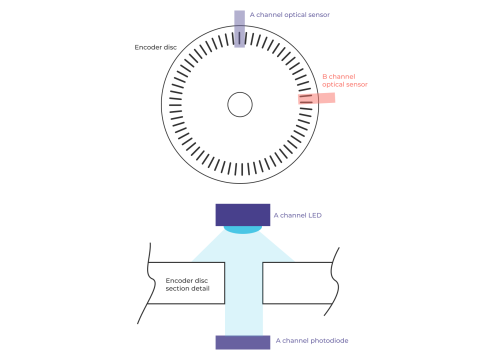Optical sensors (often referred to as photoelectric or opto-electronic sensors) operate by monitoring variations in light intensity, typically in the infrared range. Using an emitter (light source) and a receiver (photodetector), they detect objects, measure displacement, or identify smoke and flame. Below, we discuss the fundamental workings of optical sensors, their main types, and how they are applied in industry, security, and access control.
1. Principles of Optical Sensing
1.1 Light Transmission and Detection
Most optical sensors rely on one of the following detection methods:
- Beam Interruption (Through-Beam Sensor)
- Separate Transmitter & Receiver: Placed opposite each other, forming a light barrier.
- Detection Event: Occurs when an object passing between them interrupts the beam, causing a drop in detected light intensity.
- Retroreflective Setup
- Single Housing (Emitter + Receiver): A retroreflector (mirror or reflective tape) bounces the emitted light back to the receiver.
- Detection Event: Occurs when an object breaks that reflected path.
- Diffuse Reflection
- Emitter & Receiver in One Unit: The sensor picks up light reflected by the target object.
- Detection Event: If the object’s surface sufficiently reflects the emitted light, the receiver measures higher intensity, signaling presence.
By focusing on the infrared range, devices reduce interference from ambient lighting and achieve better reliability at relatively low power outputs.
1.2 Key Considerations
- Surface Reflectivity: Objects with low IR reflectance may reduce detection accuracy in diffuse setups.
- Dust or Debris: Heavily soiled environments can attenuate the optical path, leading to signal drop.
- Beam Alignment: Through-beam sensors typically require precise alignment between transmitter and receiver.
2. Main Types of Optical Sensors
2.1 Through-Beam (One or Two Units)
Two-Unit Systems: The emitter and receiver are housed separately and face each other across the detection zone. When an object interrupts the beam, the receiver signal drops, producing a switch event.
Reflective (Retroreflective) Systems: Both emitter and receiver share a single enclosure; a reflector is installed opposite. Interruption arises if the returning beam is blocked.
Benefits:
- Stable operation over longer distances than reflective methods
- Fewer background reflections or ambient light concerns
2.2 Diffuse Reflection
The sensor and the photodetector are co-located. Detection relies on light reflecting from the object.
- Pros: Easy to install (only one device needed)
- Cons: Dependence on object reflectivity, typically shorter range
2.3 Multi-Beam and Multi-Axis Systems
For advanced detection, sensors can incorporate multiple parallel or crossed beams to identify object direction or shape. By analyzing the sequence in which beams are broken, a controller can infer movement or count objects.
3. Applications of Optical Sensors
3.1 Automation and Machine Vision
- Conveyor Monitoring: Checking presence/absence or position of parts
- Quality Control: Detecting color changes or surface markings (specialized optical sensors)
- Pick and Place Systems: Verifying part alignment or orientation
3.2 Security and Fire Safety
- Perimeter Protection (Photoelectric Beams): Using line-of-sight sensors to form an IR barrier; triggers an alarm if intruded
- Smoke Detection: Certain smoke detectors rely on IR or visible light scattering or absorption (similar principle but adapted for smoke particulates)
- Flame Detection: Optical sensors calibrated to detect the spectral signature of flames
3.3 Access Control (Turnstiles, Doors)
- Entry/Exit Counting: Ensuring authorized passage in single-file through doorways
- Automatic Doors: Sensing occupant approach or passage for opening/closing
- Safety Systems: Stopping a garage door or gate if a beam is broken
4. Key Factors When Choosing an Optical Sensor
-
Environmental Conditions:
- Dust/Smoke: Excessive contaminants can reduce IR signal strength. Regular cleaning of lenses or protective housings may be needed.
- Moisture: Certain sensors have higher IP ratings for outdoor or washdown environments.
-
Mounting and Alignment:
- Through-beam setups require precise alignment.
- For reflectors, confirm stable mounting and correct distance for reflection.
-
Operating Range:
- Typical detection distances vary from a few centimeters to tens of meters.
- The larger the range, the less precise the positional accuracy may be.
-
Output and Integration:
- Typical outputs: on/off switch signals, analog readings (rare), or specialized digital data.
- Choose a sensor that matches your control or PLC input, whether it’s PNP, NPN, or relay contacts.
5. Advantages and Limitations
5.1 Advantages
- Non-Contact Detection: No mechanical wear, suitable for fragile or sensitive objects.
- Rapid Response: High-speed detection of fast-moving targets, especially in industrial lines.
- Versatility: Available in various form factors (through-beam, reflective, diffuse) for different tasks.
5.2 Limitations
- Dependence on Optical Clarity: Dust, fog, or reflective backgrounds may cause false readings or signal attenuation.
- Object Reflectivity: Diffuse sensors heavily depend on surface color or finish.
- Alignment Sensitivity: Particularly in through-beam or reflective solutions.
6. Trends and Evolution
Continual improvements in optoelectronics are leading to:
- Smaller, More Integrated Sensors: Increased miniaturization for embedded designs
- Higher Sensitivity and Range: Use of advanced IR LEDs or laser diodes for extended detection distances
- Smart Optics: Incorporation of microcontrollers for self-diagnostics, advanced filtering, or better noise rejection
- Multi-Dimensional Sensing: Combining IR detection with other sensing modalities (e.g., ultrasonic) for robust detection
Conclusion
Optical sensors harness changes in light intensity—most often in the infrared spectrum—to detect objects, motion, or environmental changes. They play a vital role in industrial automation (e.g., conveyor lines), security (motion barriers, perimeter detection), and access control (turnstiles, door sensors). By choosing the appropriate configuration (through-beam, retroreflective, or diffuse) and calibrating for environmental conditions, optical sensors deliver precise, contactless detection.
However, they must be installed carefully—particularly in dusty or reflective conditions—and require occasional maintenance to keep lenses clear. For more information on selecting and integrating optical sensors into your automation or security projects, safsale.com offers expert guidance, ensuring reliable, high-performance detection solutions.

